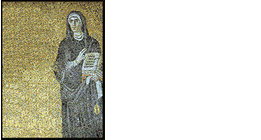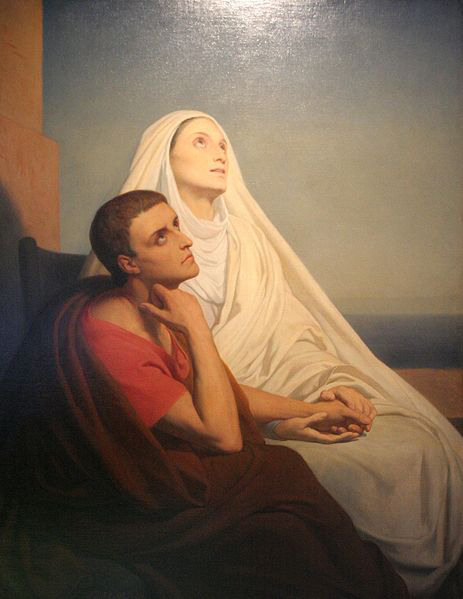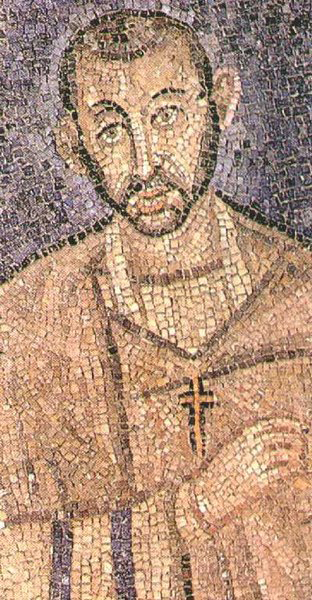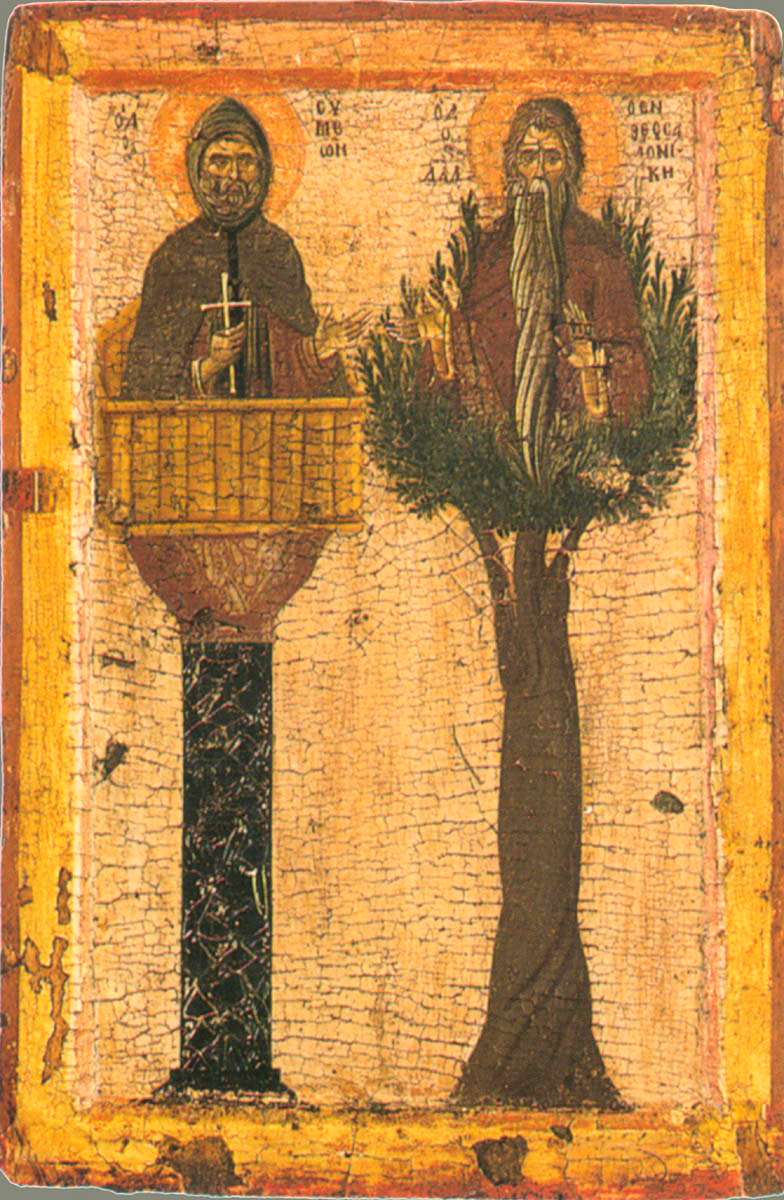 |
|
|
|
| Class
Prep |
|
|
|
Real
(Christian) Men: An Oxymoron?

- We turn from women to men today, to see whether ascetic male Christians
were also renegotiating gender as they cultivated the life of the spirit. It's
a well-known fact that, as early as the second century, Christianity began to
attract well-educated Roman men, even while Christianity's detractors like Celsus
tried to shame them by branding Christianity a superstition attractive only to
women, children and slaves. This tactic of gendering one's enemies feminine in order to associate them with vice and weakness is of course a rhetorical ploy that Christians themselves will embrace (the men, that is). By the fourth century, Christians like Augustine (pictured to the right, with his mother Monica) and Ambrose (below) are claiming that it is the pagans who are prone to vice and decadence; it is their gods and indeed their polytheistic system that is irrational.
-
- The first part of the primary reading for today is drawn frm Augustine's works, The City of God and On the Trinity. Read the secondary article by Matthew Kuefler first, so that you understand the context for the short excerpts from Augustine (Kuefler speaks about these excerpts). As you read Kuefler, consider the following questions:
-
 -
- Kuefler adds some gender roles to the attributes of the ideal Roman man that we discussed earlier in the quarter (confident and persuasive public speaking ability, pietas, self-control). What are they?
- Discuss how Ambrose, Augustine and other western Roman Christians acknowledge that they are NOT your typical Roman man while at the same time asserting that they are MORE manly than their pagan counterparts.
- What is going on in the Roman Empire that is leading people to question the manly ideal of the past? How does this "failure" contribute to the Christians' success in drawing converts to their alternative "man"?
- Who gets feminized in this quest to outman each other?
- There were so many Christians
in the cities that some Christian men (and women) began to leave the cities and
live in the wildernesses just beyond them. There, away from the distractions and
temptations of society, wealth, spouses and family, they could pursue the life
of the spirit unfettered.
-
 Part
of the reason this lifestyle became so popular is that early Christian authors
wrote about it. The first biography of a desert ascetic was Athanasius' Life
of Antony, and it was wildly popular. Even those who didn't abandon everything
and migrate to the wilderness were nevertheless inspired to visit these desert
abbas and ammas, and to cultivate similar ascetic virtues at home.
Part
of the reason this lifestyle became so popular is that early Christian authors
wrote about it. The first biography of a desert ascetic was Athanasius' Life
of Antony, and it was wildly popular. Even those who didn't abandon everything
and migrate to the wilderness were nevertheless inspired to visit these desert
abbas and ammas, and to cultivate similar ascetic virtues at home.
-
- As you read this brief excerpt, consider how the "desire" of the monks is reconfigured from sex, wealth and human society to other goals. Is Athanasius anxious to prove how manly these seemingly impotent men are? What sort of battles do they wage, and against what enemies?
-
- The
student excavator, if we have one, will focus today on the city of Rome, where Augustine
and the other Christian noblemen mentioned in Kuefler's article spent a great
deal of their time.
-
-
- Assigned Readings
-
- Primary: Excerpts from Augustine's City of God and On the Trinity, and from Athanasius of Alexandria, Life of Antony (Camino)
-
- Secondary: Kuefler, "The Manliness of Faith: Sexual Difference and Gender Ambiguity in Latin Christian Ideology," pp. 206-244 in The Manly Eunuch (Camino); online class prep
-
- Slides for Lecture
-
-
- Today's Author
-
-
-
- Dig Site 8: Manly Values in Rome (Italy)
-
-
- Further Reading
-
- Barnes, Timothy David. "Angel of Light or Mystic Initiate: The Problem of the Life of Antony." Journal of Theological Studies n.s. 37 (1986) 353-68.
-
- Brennan, Brian. "Athanasius' Vita Antonii: A Sociological Interpretation." Vigiliae
christianae 39 (1985) 209-227.
-
- Brown, Peter R. L. The Body and Society: Men, Women, and Sexual Renunciation in Early Christianity. New York: Columbia University Press, 1988.
-
- Burrus, Virginia. "Begotten, Not Made": Conceiving Manhood in Late Antiquity, Figurae: Reading Medieval
Culture 39. Stanford, California: Stanford University Press, 2000.
-
- --------. The Sex Lives of Saints: An Erotics of Ancient Hagiography, Divinations: Rereading Late Ancient Religion. Philadelphia: University of Pennsylvania Press, 2004.
-
- Burton-Christie, Douglas. The Word in the Desert: Scripture and the Quest for Holiness in Early Christian Monasticism. New York: Oxford University Press, 1993.
-
- Coleiro, E. "St. Jerome's Lives of the Hermits." Vigiliae Christianae 11 (1957) 161-78.
-
- Harmless, William. Desert Christians: An Introduction to the Literature of Early Monasticism. New York: Oxford University Press, 2004.
-
- Kuefler, Mathew. The Manly Eunuch: Masculinity, Gender Ambiguity, and Christian Ideology in Late Antiquity,
The Chicago Series on Sexuality, History, and Society. Chicago: University of Chicago Press, 2001.
-
- Louth, Andrew. ""St. Athanasius and the Greek Life of Antony." Journal of Theological Studies n.s. 39 (1988) 504-509.
-
- Miller, Patricia Cox. "Jerome's Centaur: A Hyper-Icon of the Desert." Journal of Early Christian
Studies 4 (1996) 209-233.
-
- Pettersen, Alvyn. "Athanasius' Presentation of Antony of the Desert's Admiration for His Body." Studia patristica 21 (Louvain: Peeters, 1989) 438-47.
-
- Robins, William. "Romance and Renunciation at the Turn of the Fifth Century." Journal
of Early Christian Studies 8 (2000) 531-57.
-
- Rousseau, Philip. Ascetics, Authority, and the Church in the Age of Jerome and Cassian, Oxford Historical Monographs. New York: Oxford University Press, 1978.
-
- Samuil, Bishop, and Peter Grossmann. "Researches in the Laura of John Kolobos (Wâdî al-Natrûn)." In Ägypten und Nubien in spätantiker und christlicher Zeit: Akten des 6. Internationalen Koptologenkongresses, Münster 20.–26. Juli 1996, vol. 2, Materielle Kultur, Kunst und religiöses Leben (ed. Stephen Emmel, Martin Krause, Siegfried G. Richter and Sofia Schaten; Sprachen und Kulturen des christlichen Orients 6; Wiesbaden: Reichert, 1999) 360–64.
-
- Ward, Benedicta. The Desert Christians: Sayings of the Desert Fathers, Alphabetic Collection. New York: Macmillan, 1975.
-
- Williams, Michael A. "The Life of Antony and the Domestication of Charismatic Wisdom." Journal
of the American Academy of Religion Thematic Studies 48 (1982) 23-45.
-
-
- Links
-
- Wadi al-Natrun Project - page for the Yale Egyptological Institute in Egypt's current excavations in the Wadi al-Natrun, focusing at the moment on the Monastery of St. John the Little.
-
-
- Sources
-
- Photographs:
-
- Ary Scheffer, Saint Augustin et Sainte Monique (1858), online, "File:Sainte Monique.jpg," Wikipedia.com (2009), http://en.wikipedia.org/wiki/
File:Sainte_Monique.jpg, accessed 25 January 2013.
-
- Ambrose of Milan, 5th century mosaic (probably a portrait), at Sant' Ambrogio, Milan, online,"HONS 1001 Syllabus," Seton Hall University Honors Program (Fall 2012), online, http://academic.shu.edu/honors/AmbroseOfMilan.jpg, accessed 25 January 2013.
-
- Icon of St. Simon the Stylite and St. Denis of Thessaloniki, the Dendrite, "St. David of Thessaloniki the Dendrite,"Full of Grace and Truth Blogspot (25 June 2012), online, http://full-of-grace-and-truth.blogspot.fr/2012/06/st-david-of-thessaloniki-dendrite.html, accessed 6 January 2017.
-
-
|
|
|
|
|
|
|
